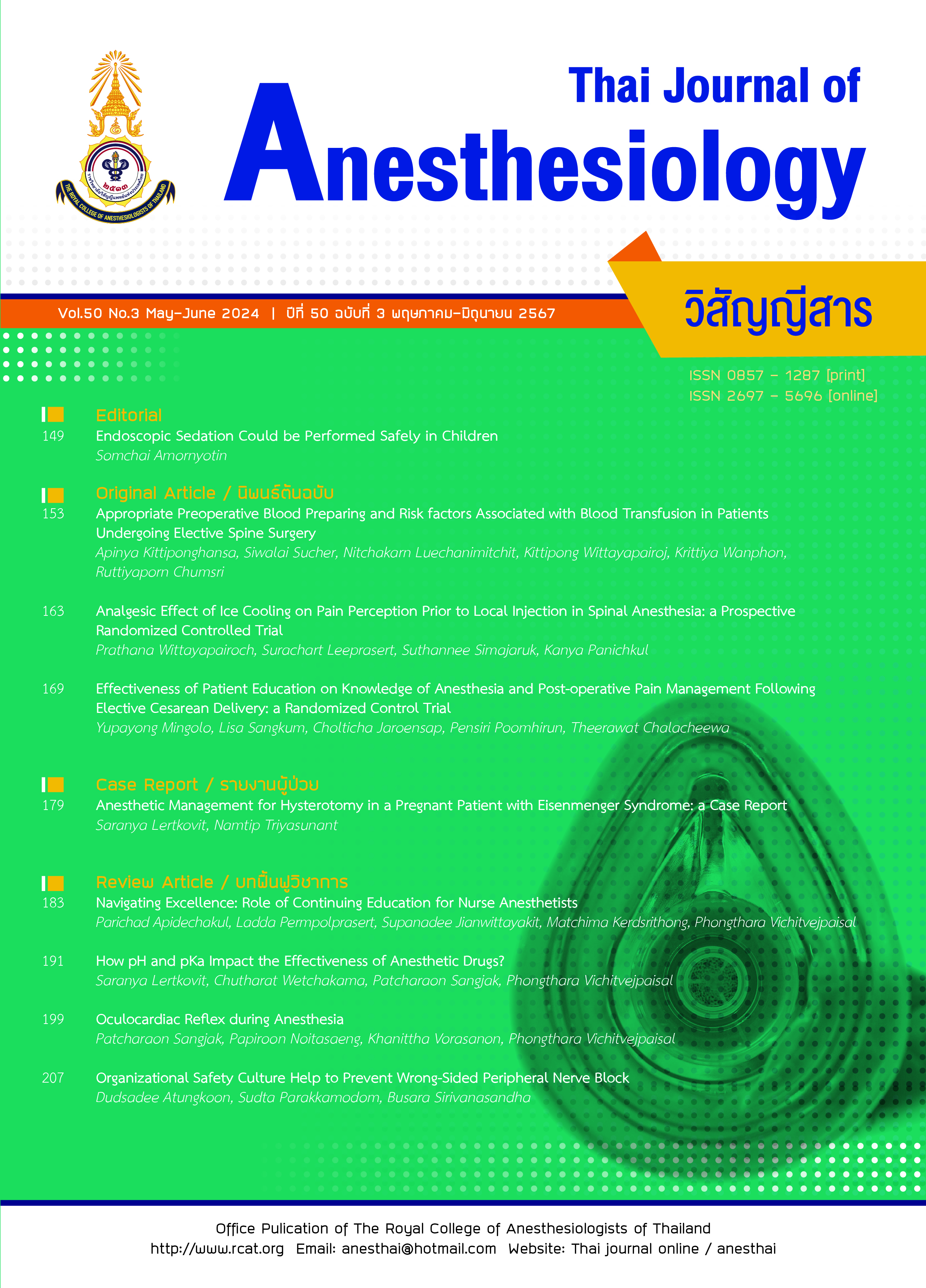Endoscopic Sedation Could be Performed Safely in Children
Main Article Content
Abstract
For gastrointestinal endoscopic (GIE) procedures in children, general anesthesia by a multidisciplinary team led by an anesthesiologist is generally preferred. To date, the growing number of pediatric GIE procedures requiring sedation and analgesia are recognized even in Thailand.1-3 Intravenous sedation for children undergoing these procedures involves careful consideration of safety and best practices to ensure the well-being of the child throughout the procedure. The ability to provide safe and effective sedation and analgesia is an important skill for anesthetic personnel involved in pediatric patients. Children are more prone to anxiety in the acute care setting. Procedural sedation is the use of sedative, analgesic and dissociate drugs to provide anxiolysis, analgesia, sedation and motor control during painful and unpleasant procedures. However, intravenous sedation for pediatric GIE procedure is pervasive in any hospital that cares for children and depending on the institution and country. Sedation-related adverse events could be reduced by proper preprocedural assessment, appropriate sedation technique and careful postprocedural management.4
Article Details

This work is licensed under a Creative Commons Attribution-NonCommercial-NoDerivatives 4.0 International License.
References
Amornyotin S, Prakanrattana U, Chalayonnavin W, Kongphlay S, Chantakard S. Anesthesia for pediatric gastrointestinal endoscopy in a tertiary care teaching hospital. Thai J Anesthesiol. 2008;34:265-72.
Amornyotin S, Aanpreung P. Clinical effectiveness of an anesthesiologist-administered intravenous sedation outside of the main operating room for pediatric upper gastrointestinal endoscopy in Thailand. Int J Pediatr. 2010;2010:748564.
Amornyotin S, Aanpreung P, Prakanrattana U, Chalayonnavin W, Chatchawankitkul S, Srikureja W. Experience of intravenous sedation for
pediatric gastrointestinal endoscopy in a large tertiary referral center in a developing country. Pediatr Anesth. 2009;19:784-91.
Amornyotin S. Sedation-related complications in gastrointestinal endoscopy. World J Gastrointest Endosc. 2013;5:527-33.
Cote CJ, Wilson S. Guidelines for monitoring and management of pediatric patients before, during, and after sedation for diagnostic and therapeutic procedures. Pediatrics. 2019;143:e20191000.
Amornyotin S. Sedative and analgesic drugs for gastrointestinal endoscopic procedure. J Gastroenterol Hepatol Res. 2014;3:1133-44.
Amornyotin S. Intravenous sedation techniques for gastrointestinal endoscopy. J Gastroenterol Hepatol Res. 2016;5:2050-7.
Amornyotin S. Sedation and monitoring for gastrointestinal endoscopy. World J Gastrointest Endosc. 2013;5:47-55.
Amornyotin S, Chalayonnavin V, Kongphlay S. Recovery pattern and home-readiness after gastrointestinal endoscopy. J Med Assoc Thai. 2007;90:2352-8.
Orel R, Brecelj J, Dias JA, et al. Review on sedation for gastrointestinal tract endoscopy in children
by non-anesthesiologists. World J Gastrointest Endosc. 2015;7:895-911.
Kamat PP, McCracken CE, Simon HK, et al. Trends in outpatient procedural sedation: 2007-2018. Pediatrics. 2020;145:e20193559.
Lightdale JR, Liu QY, Sahn B, Troendle DM, Thomson M, Fishman DS, NASPGHAN Endoscopy and Procedures Committee. Pediatric endoscopy and high-risk patients: a clinical report from the NASPGHAN Endoscopy Committee. J Pediatr Gastroenterol Nutr. 2019;68:595-606.
Gozal D, Drenger B, Levin PD, Kadari A, Gozal Y. A pediatric sedation/anesthesia program with dedicated care by anesthesiologists and nurses for procedures outside the operating room.
J Pediatr. 2004;145:47-52.
Amornyotin S, Kongphlay S. Esophagogastroduodenoscopy procedure in sick pediatric patients: a comparison between deep sedation and general anesthesia technique. J Anesth Clin Res. 2012;3:1000185.

